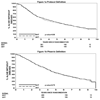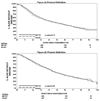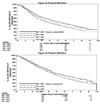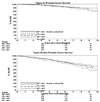An update of the phase III trial comparing whole pelvic to prostate only radiotherapy and neoadjuvant to adjuvant total androgen suppression: updated analysis of RTOG 94-13, with emphasis on unexpected hormone/radiation interactions
- PMID: 17531401
- PMCID: PMC2917177
- DOI: 10.1016/j.ijrobp.2007.04.003
An update of the phase III trial comparing whole pelvic to prostate only radiotherapy and neoadjuvant to adjuvant total androgen suppression: updated analysis of RTOG 94-13, with emphasis on unexpected hormone/radiation interactions
Abstract
Purpose: This trial was designed to test the hypothesis that total androgen suppression and whole pelvic radiotherapy (WPRT) followed by a prostate boost improves progression-free survival (PFS) by > or =10% compared with total androgen suppression and prostate only RT (PORT). This trial was also designed to test the hypothesis that neoadjuvant hormonal therapy (NHT) followed by concurrent total androgen suppression and RT improves PFS compared with RT followed by adjuvant hormonal therapy (AHT) by > or =10%.
Methods and materials: Patients eligible for the study included those with clinically localized adenocarcinoma of the prostate and an elevated prostate-specific antigen level of <100 ng/mL. Patients were stratified by T stage, prostate-specific antigen level, and Gleason score and were required to have an estimated risk of lymph node involvement of >15%.
Results: The difference in overall survival for the four arms was statistically significant (p = 0.027). However, no statistically significant differences were found in PFS or overall survival between NHT vs. AHT and WPRT compared with PORT. A trend towards a difference was found in PFS (p = 0.065) in favor of the WPRT + NHT arm compared with the PORT + NHT and WPRT + AHT arms.
Conclusions: Unexpected interactions appear to exist between the timing of hormonal therapy and radiation field size for this patient population. Four Phase III trials have demonstrated better outcomes when NHT was combined with RT compared with RT alone. The Radiation Therapy Oncology Group 9413 trial results have demonstrated that when NHT is used in conjunction with RT, WPRT yields a better PFS than does PORT. It also showed that when NHT + WPRT results in better overall survival than does WPRT + short-term AHT. Additional studies are warranted to determine whether the failure to demonstrate an advantage for NHT + WPRT compared with PORT + AHT is chance or, more likely, reflects a previously unrecognized biologic phenomenon.
Figures







Comment in
-
Updated analysis of RTOG 94-13: in regard to Lawton et al. (Int J Radiat Oncol Biol Phys 2007;69:646-655).Int J Radiat Oncol Biol Phys. 2008 May 1;71(1):315; author reply 315-6. doi: 10.1016/j.ijrobp.2008.01.021. Int J Radiat Oncol Biol Phys. 2008. PMID: 18406897 No abstract available.
-
An update of the phase III trial comparing whole pelvic to prostate only radiotherapy and neoadjuvant to adjuvant total androgen suppression: updated analysis of RTOG 94-13, with emphasis on unexpected hormone/radiation interactions: in regard to Lawton et al. (Int J Radiat Oncol Biol Phys 2007;69:646-655.).Int J Radiat Oncol Biol Phys. 2008 May 1;71(1):316; author reply 316. doi: 10.1016/j.ijrobp.2008.01.009. Int J Radiat Oncol Biol Phys. 2008. PMID: 18406900 No abstract available.
References
-
- Pilepich M, Winter K, Lawton C, et al. Androgen suppression adjuvant to definitive radiotherapy in prostate carcinoma long term results of phase III RTOG 85-31. Int J Rad Onc Biol Phys. 2005;61(5):1285–1290. - PubMed
-
- Pilepich MV, Winter K, Fu KKM, et al. Phase III Radiation Therapy Oncology Group (RTOG) trial 86-10 of androgen deprivation adjuvant to definitive radiotherapy in locally advanced carcinoma of the prostate. Int J Rad Onc Bio Phys. 2001;50(5):1243–1252. - PubMed
-
- Bolla M, Collette L, Blank L, et al. Long term results with immediate androgen suppression and external irradiation in patients with locally advanced prostate cancer (an EORTC study, a phase III randomized trial) Lancet. 2002;360:103–108. - PubMed
-
- Hanks GF, Pajak T, Porter A, et al. Phase III trial of long-term adjuvant androgen deprivation after neoadjuvant hormonal cytoreduction and radiotherapy in locally advanced carcinoma of the prostate: RTOG Protocol 92-02. Journ Clin Oncol. 2003;21(21):3972–3978. - PubMed
-
- Roach M. Re: The use of prostate specific antigen, clinical stage and Gleason score to predict pathological stage in men with localized prostate cancer. J Urol. 1993;150:1923–1924. - PubMed
Publication types
MeSH terms
Substances
Grants and funding
LinkOut - more resources
Full Text Sources
Medical

